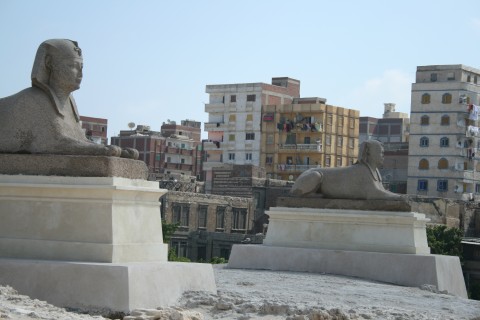In the winter of 332/331 B.C. Alexander the Great conquered Egypt. He took it from the Persians who had ruled there for centuries. On 7 April 331 Alexandria was founded, which grew into a metropolis of a million inhabitants. The harbour furnished a gateway to the Mediterranean Sea and developed into a centre for international trade. All this was unprecedented in Egypt.
Alexandria had a separate judicial jurisdiction and, together with the fertile land along the Nile, became the power base of the Ptolemaic dynasty, named after its founder Ptolemy I, one of Alexander's generals and his successor in Egypt. It soon began to play a crucial role in international politics. It was a Greek city with the streets laid out on a grid, where the sovereigns had their palaces. The world-famous library of Alexandria housed scrolls of literary and scientific works which were made available to the foremost authors and researchers. Its renowned lighthouse was literally a beacon for seafarers.
Power and religion
The Ptolemies (APM08797) used their wealth and power to influence international politics. Although their apex falls in the third century B.C. and the beginning of the second, the role of Ptolemaic Egypt was not entirely played out until the death of queen Cleopatra in 30 B.C. This intelligent female ruler was the last member of the Ptolemaic dynasty to govern Egypt. When Rome became the power centre of the western world Egypt had to be content with the status of a province.
The Ptolemies founded a national religion centred on Serapis. The cult was geared to appeal to both immigrants and the Egyptians themselves. Serapis had his largest temple in Alexandria, but his sanctuaries were found everywhere. With his luxuriant beard and wealth of hair, Serapis had the reassuring appearance of a Greek god. In character, he greatly resembled Osiris, as he was also a god of the dead. And the popular goddess Isis became his consort and the small Horus, known as Harpocrates, their son. Thus a sacred family was created which underpinned a religious creed. Within the Roman empire, the three gods were revered so far afield as the Rhine and the Thames.
During the Hellenistic period and under the Roman emperors Egypt adhered closely to its own religious traditions. Many of the temples we see today were built by the Ptolemies and the Roman emperors in their capacity as pharaohs. Under the Romans, however, Christianity found an increasingly large following.
Osiris and Isis
Osiris was the benevolent god of life and resurrection after death. He was the object of a ruse which had fatal consequences: he was cut into pieces by the cunning Seth, the personification of evil. But Isis was able to reassemble all the pieces, which were scattered along the Nile, and bring them back to life. Thus she is pre-eminently the loving wife who, wonder of wonders, bore Osiris a son: Horus. Afterwards, Horus avenged his father, a story which was enacted in the temple of Edfu. Everyone in Egypt knew about the marvel of Osiris, his wife Isis and their son Horus. In the first century A.D. Plutarch, who wrote in Greek, tells this Egyptian story in detail.
Over the centuries, Isis absorbed aspects of other goddesses, and Egyptian queens identified with her. Large or small, expensive or cheap, the representations of Isis breastfeeding her baby son are innumerable. During the Graeco-Roman period an image of the standing Isis emerged which shows Horus seated on a lotus flower held in her outstretched hand. The lotus flower was an Egyptian symbol of new life.
Towns and villages had their own gods with their own major and minor festivals, which sometimes attracted thousands of pilgrims. Animals could be the focal point, worshipped as the earthly incarnations of deities. Elsewhere, the canonical gods were venerated in different forms. For instance, Osiris had a cult at Canopus in the Nile Delta where, especially in the first centuries of our era, he was represented as a rounded vase, called 'Canopus'; the lid has the shape of the god's head furnished with a king's cap (APM07874). Such images of Osiris were associated with their blessed content: Nile water.
Mummy portraits
The Egyptian techniques and practices of mummification and the burial of human remains developed over centuries, even millennia. The corpses of common people were simply left to dry out in the desert sand. But whoever could afford it would obviously seek the services of an expert in mummification. In Graeco-Roman times it was customary, at home, to stand the mummy of a deceased relative upright in the coffin for a while before burial. A wooden panel with a depiction of the deceased was placed over the face which, like the rest of the body, was tightly wrapped in linen bands. Hundreds of such portraits of ancient inhabitants of the Nile valley have come down to us in this form.
The skill of the painters greatly varied. Also the different regions of Egypt had their own artistic traditions. Some portraits appear life-like, all of them capture the observers' attention because of the shading which always creates some fascinating sense of realism. They are painted in the encaustic technique which employs molten wax coloured with pigments. In the first century A.D. Pliny the Elder mentioned the technique, whose exact details remain a point of discussion today.
The mummy was encased in wood and plaster or sometimes clay mixed with straw. Often the head, hands, feet and, in the case of women, breasts were shown in relief. The glance of the female mummy case in the Museum, with its outlined eyes and rich coiffure, is directed towards the feet, the point where her relatives are shown venerating her as a resurrected soul. The hairstyle, garments and jewellery are so carefully rendered that they are a source of archaeological information.
